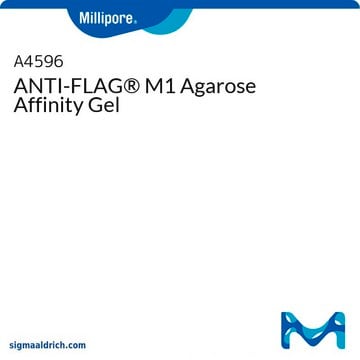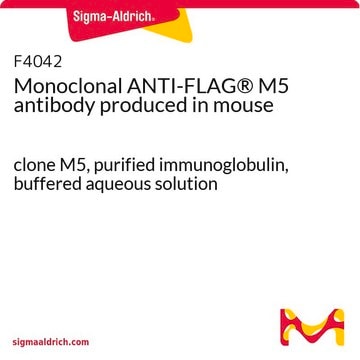F3040
Monoklonaler ANTI-FLAG® M1 in Maus hergestellte Antikörper
clone M1, purified immunoglobulin, buffered aqueous solution
Synonym(e):
Anti-ddddk, Anti-dykddddk
About This Item
Empfohlene Produkte
Biologische Quelle
mouse
Konjugat
unconjugated
Antikörperform
purified immunoglobulin
Antikörper-Produkttyp
primary antibodies
Klon
M1, monoclonal
Form
buffered aqueous solution
Aufgereinigt durch
using Protein A
Speziesreaktivität
all
Konzentration
2-5 mg/mL
Methode(n)
western blot: 10 μg/mL
Immunogene Sequenz
DYKDDDDK
Versandbedingung
dry ice
Lagertemp.
−20°C
Verwandte Kategorien
Allgemeine Beschreibung
Aufbereitungsmethode – Protein A
Immunogen
Anwendung
Anwendungen, bei denen dieser Antikörper erfolgreich eingesetzt wird, und die dazugehörigen Peer-Review-Papers sind nachstehend aufgeführt.
Chromatin-Immunpräzipitation (1 Paper)
Immunfluoreszenz (1 Paper)
Weitere Produktinformationen finden Sie in unserem FLAG-®Literatur-Portal.
Biochem./physiol. Wirkung
Physikalische Form
Angaben zur Herstellung
Sonstige Hinweise
Rechtliche Hinweise
Not finding the right product?
Try our Produkt-Auswahlhilfe.
Lagerklassenschlüssel
10 - Combustible liquids
WGK
WGK 1
Flammpunkt (°F)
Not applicable
Flammpunkt (°C)
Not applicable
Analysenzertifikate (COA)
Suchen Sie nach Analysenzertifikate (COA), indem Sie die Lot-/Chargennummer des Produkts eingeben. Lot- und Chargennummern sind auf dem Produktetikett hinter den Wörtern ‘Lot’ oder ‘Batch’ (Lot oder Charge) zu finden.
Besitzen Sie dieses Produkt bereits?
In der Dokumentenbibliothek finden Sie die Dokumentation zu den Produkten, die Sie kürzlich erworben haben.
Kunden haben sich ebenfalls angesehen
Unser Team von Wissenschaftlern verfügt über Erfahrung in allen Forschungsbereichen einschließlich Life Science, Materialwissenschaften, chemischer Synthese, Chromatographie, Analytik und vielen mehr..
Setzen Sie sich mit dem technischen Dienst in Verbindung.













